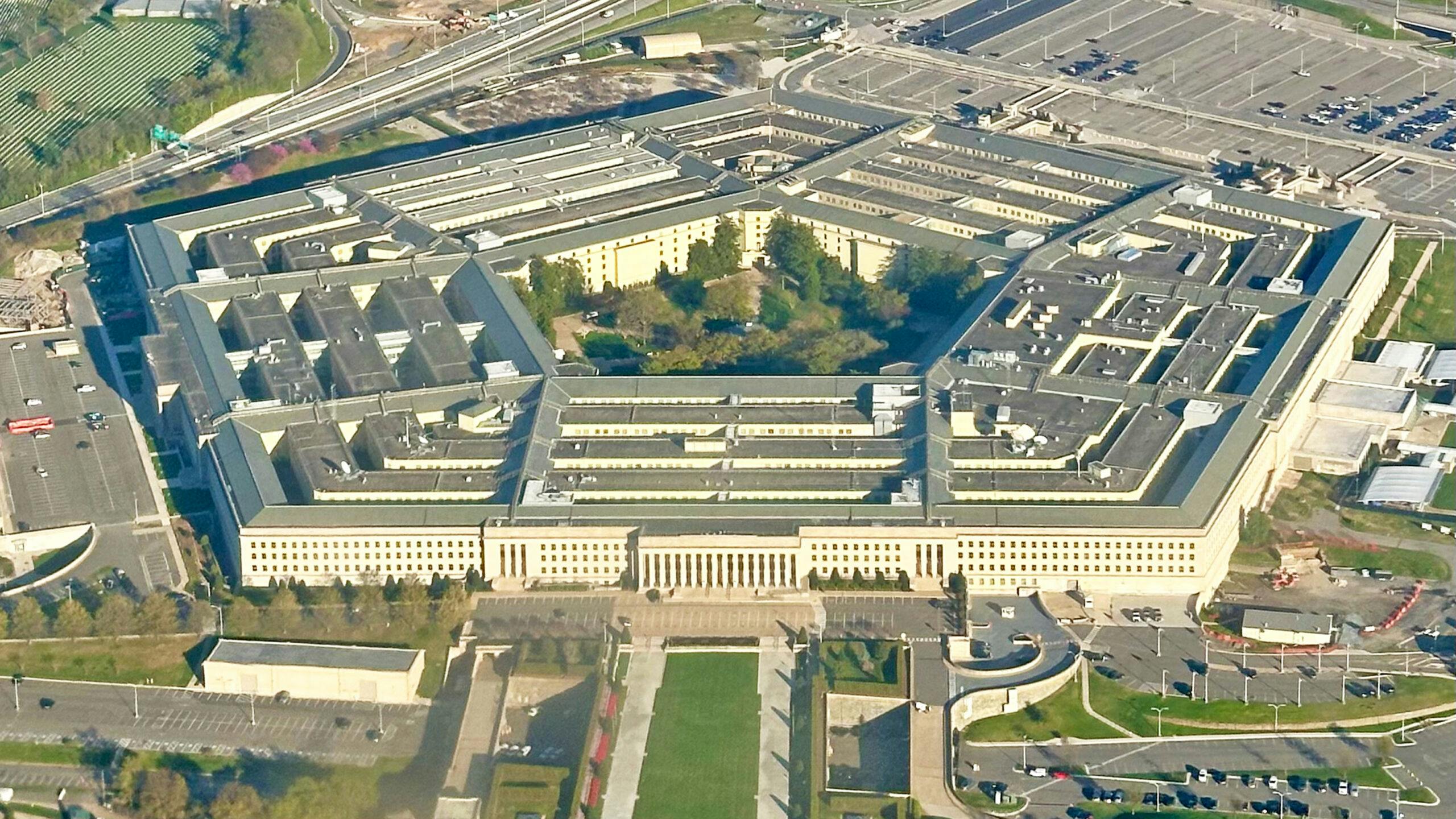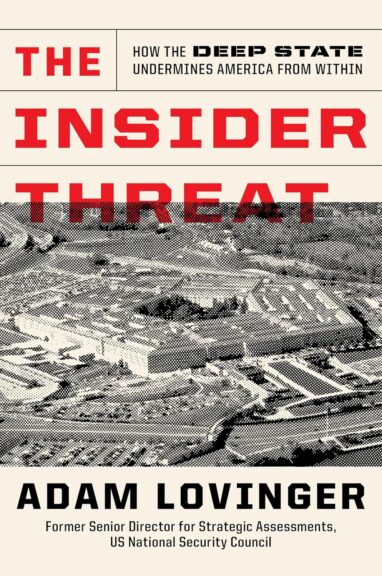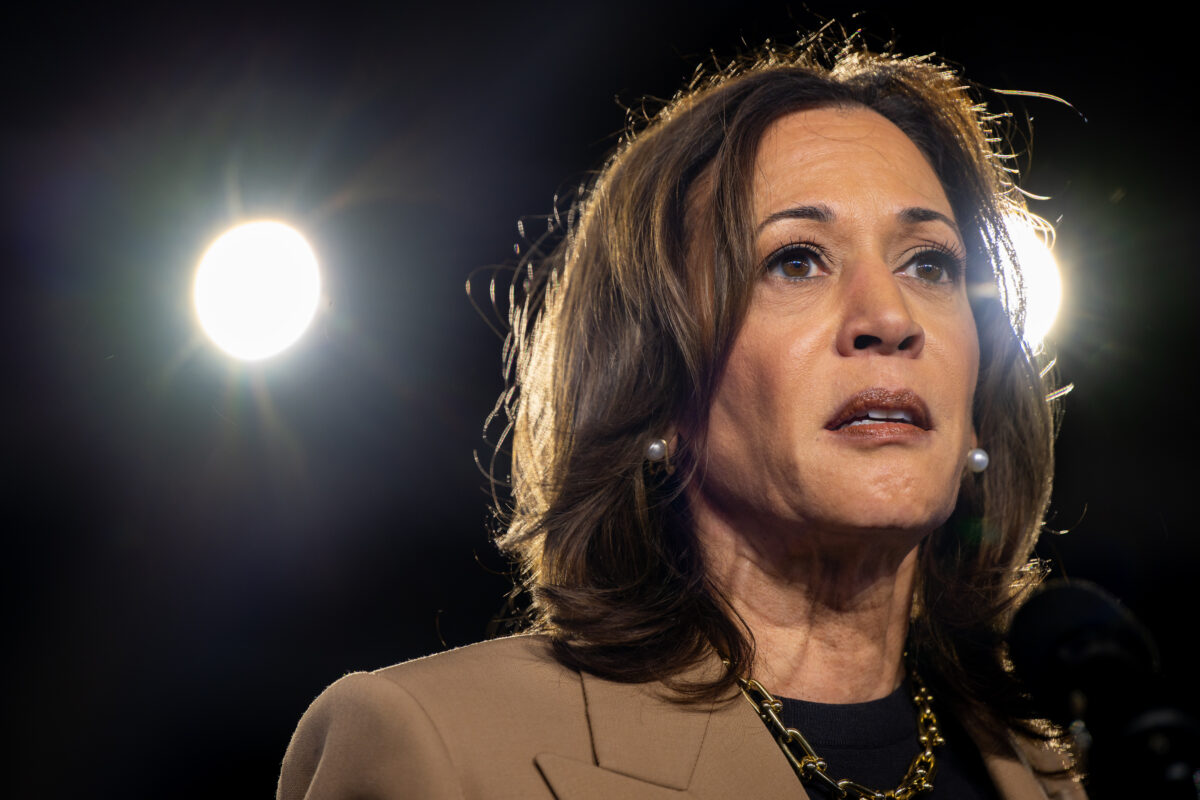When The Deep State Came For Me
The following is an excerpt from the new book “The Insider Threat: How the Deep State Undermines America from Within,” by Adam Lovinger, (November 19, 2024, Encounter Books) * * * Targeting A Presidential Transition Team On January 11, 2017, nine days before the start of the Trump administration, three members of the NSC Presidential Transition ...

The following is an excerpt from the new book “The Insider Threat: How the Deep State Undermines America from Within,” by Adam Lovinger, (November 19, 2024, Encounter Books)
* * *
Targeting A Presidential Transition Team
On January 11, 2017, nine days before the start of the Trump administration, three members of the NSC Presidential Transition Team called [James H.] Baker in his Pentagon office to inform him that I would be leaving ONA [Office of Net Assessment] to join the Trump administration’s NSC. By then Baker was infamous at PTT headquarters. As the Pentagon PTT lead later told me, Baker had already illegally concealed ONA work product from her team. Baker did that by classifying unclassified ONA contractor reports.
Alerted to Baker’s schemes, the NSC PTT leadership insisted on a conference call so there would be witnesses to what Baker told them about me.
“General Flynn wants Adam Lovinger to serve as his Senior Director for Strategic Assessments on the NSC,” one member of the PTT said.
There was a long pause.
“That could be a problem,” Baker said. “How so?”
“Adam is currently under investigation for serious misconduct in the performance of his official duties. That investigation will be finished soon. Would General Flynn be willing to take someone else from my staff?”
“No, the general wants Adam.”
There was another pause. Then Baker reluctantly agreed to release me to the NSC immediately.
What those who joined the Trump administration would soon realize was that they were not in power. The Deep State held the real power in the U.S. national security, intelligence, and law enforcement federal bureaucracies. Trump administration officials, even very senior ones, who could not be coopted by the Deep State to do its bidding and insisted on holding those bureaucracies accountable for following U.S. law, would have their careers and reputations destroyed.(4)
Two days later, on January 13, 2017, [Anthony L.] Russell wrote to Baker that I posed a “professional threat” to them both:
Sir, I was just asked by Adam Lovinger to walk out with him as he departed ONA for the day He indicated that he believed
your treatment of Mike [Pillsbury, then on the Trump Presidential Transition Team], including inquiries to the CIA, were violations of the Privacy Act and the Hatch Act. I took this
as an explicit professional threat toward you and an implied one toward myself and I chose to not respond at all and simply turned and walked away. Immediately upon returning to the office I shared the contents of this conversation with Andrew May to ensure a witness to the events and my response, or lack thereof. (5)
Russell’s reference to “inquiries to the CIA” related to Baker’s gathering a security file on Pillsbury. His reference to the Hatch Act, a federal statute that forbids executive branch officials from engaging in political activity, related to Baker’s use of CIA to gather dirt on Trump’s Presidential Transition Team.
Thanks to the playbook, I learned later that hours after receiving the above email from Russell, Baker secretly filed an “Incident Report” in my security file (on what is called the “Joint Personnel Adjudication System” or “JPAS”). That began the process of stripping me of my Top Secret/SCI security clearance. That done, Russell drafted a memo placing me on “administrative leave.”
Several days later, attorney James B. Vietti, a subordinate of WHS director Barbara Westgate, wrote me out of my ONA job description. That was May’s idea: eight months later, when I found the playbook on my DoD computer, I learned that May had suggested that WHS “eliminate Adam’s billet.”
Baker then placed Russell in charge of investigating me. But Vietti feared that what Baker and Russell were doing was too obviously illegal. On paper, legal counsel is required to stop criminal subversion of DoD processes and correct for that abuse of authority. But Vietti seemed mainly concerned that Russell wasn’t sufficiently covering up his own and others’ misconduct.
On January 17, 2017, Vietti warned Russell that Baker’s actions looked too much like “a ‘go forth and find a justification to fire him [Lovinger]’ sort of investigation.”(6) The personnel lawyer then wrote to Russell: “It looks like you’re trying to interfere with or hinder his [Lovinger’s] advancement in some way and that the email [to the NSC] would be sent after [Lovinger] complained that Baker had violated the Hatch Act.”
Despite all these behind-the-curtain efforts to derail my secondment to the NSC, on January 20, 2017, I departed by Secret Service van from the Presidential Transition Team headquarters at 18th and E Street, NW, passing through the heavy black-steel gates of the White House, and officially assumed my position as senior director for strategic assessments at the U.S. National Security Council.
The U.S. National Security Council
In Washington, proximity to power is everything. The magnificent federal buildings of DC, and the self-importance they inspire, infect almost everyone who walks their halls. Just days earlier I had been a civil servant in a Pentagon cubicle. Overnight my working environment became a suite of historically furnished offices in the majestic Eisenhower Executive Office Building (EEOB) on the corner of 17th Street and Pennsylvania Avenue.
Constructed in 1888 in the French Second Empire style, the EEOB has gracious eighteen-foot ceilings, black-and-white-checkered marble floors, and sumptuous, historically pristine period rooms. Many of the office suites have ornate marble fireplaces. In its early years the building housed the Departments of State, Army, and Navy all under one roof. Today the Navy and State Department libraries are iron-latticed oases of quiet calm.
My third-floor office was separated from the West Wing of the White House by West Executive Avenue; it was only a five-minute jaunt to the second-floor National Security Advisor’s Office, White House Situation Room, and Navy Mess. For the first time in my career, I was assigned an executive assistant and had staff reporting to me. My new job put me in the U.S. Government pecking order a little higher than an assistant secretary; I was the civilian equivalent of a three-star flag officer (that is, lieutenant general or vice admiral). But I was under no illusions. As the Founders had intended, like everyone else in the White House, even the president, I was a temporary worker, and wonderfully expendable.
* * *
Incoming National Security Advisor Michael T. Flynn was appalled to learn that ONA had done no net assessments for the entirety of the Obama administration. To correct that deficit, my job on the NSC was to, in Flynn’s words, “do ONA’s job for it.”
As I contemplated my new duties, I reflected on how my mentor and legendary first boss in ONA, Andrew W. Marshall, had held a similar position when Henry Kissinger brought him to the White House from the RAND Corporation in 1971.
Both Marshall and I had been tasked by national security advisors with guiding America’s strategic recovery from “forever wars,” and building or rebuilding the Pentagon’s and NSC’s capacity to craft and execute net assessment–informed national security strategies. Those strategies were necessary to inject more logic into our alliances and partnerships and ensure that all strategic initiatives coming out of the White House were mutually reinforcing.
But crafting strategies to end America’s directionless wars also posed a strategic threat to the Deep State–contractor nexus, which had become invested in perpetuating those wars as long as possible. A week later, I met with Flynn and several other NSC staff in his West Wing office to discuss the president’s Iran policy. As the meeting ended, Flynn asked me to stay behind.
“Baker has some serious concerns about you,” he said gravely.
That sent a cold chill down my spine. Flynn then smiled and broke into a laugh.
“You must be doing something right,” he said.
While my relief was growing exponentially by the millisecond, I still had no idea what he was talking about.
“Just like Obama warned Trump not to hire me, Jim Baker warned me not to hire you!”
Flynn was referring to a November 10, 2016, meeting between Obama and Trump. During that White House meeting, despite all the weighty world issues the outgoing president might have raised with Trump, Obama seemed monomaniacally fixated on Flynn, telling Trump not to appoint Flynn as his national security advisor.(7)
All told, Trump was beseeched three times on three separate occasions (later by National Security Advisor Susan Rice and FBI Director James Comey) not to hire Flynn. Though each of those messages had an unmistakable “or else” quality, Trump brushed them all off. If anything, these fervent objections made it clear to Trump that Flynn was the right man for the job.
* * *
On the heels of the 9/11 terrorist attacks, Michael T. Flynn had been appointed director of intelligence at the Joint Task Force 180 in Afghanistan. That was followed by a steady stream of promotions to Commander of the 111th Military Intelligence Brigade (2002–2004), then to Director of Intelligence for each of the Joint Special Operations Commands (2004–2007). Prestigious appointments to the U.S. Central Command (2007–2008), U.S. Joint Staff (2008–2009), and International Security Assistance Force in Afghanistan (2009–2010) followed.
From those positions of leadership, Flynn revolutionized U.S. counterinsurgency doctrine. As he would later detail in “Fixing Intel: A Blueprint for Making Intelligence Relevant in Afghanistan” (2010), which he coauthored with Matt Pottinger and Paul D. Batchelor, the U.S. military’s existing intelligence processes were not just broken, but self-defeating.(8)
Intelligence gathered in the field was sent back to the U.S. for analysis. This was cumbersome and untimely, and it led to poor analysis, because the analysts charged with analyzing the information from afar lacked the local knowhow to accurately interpret what they were looking at.
Flynn recommended several changes. To get actionable intelligence, U.S. forces had to win the trust of locals. That meant decamping from the safety of fortified bases and armored vehicles to live among the Afghan people. That showed the local population that Americans had skin in the game. He also shortened the analysis-operations cycle by cutting out Washington and conducting tactical intelligence assessments in the field. Those changes resulted in radical improvements in mission outcomes.
But they also posed a direct threat to the connective tissue binding for-profit contractors to U.S. national security and intelligence agencies. By the second year of the Obama administration, that nexus had achieved institutional capture of the entire enterprise. It became a major force driving the course of the wars in Iraq and Afghanistan.
In July 2012, Flynn became the eighteenth Director of the Defense Intelligence Agency (DIA). As he recounted to me years later, before assuming that role he studied ten years of DoD Inspector General audits of DIA’s expenditures of billions of U.S. taxpayer dollars. None of those audits was “clean.” For an entire decade, at least, DIA had failed to properly account for its contractor expenditures.
Seeking to root out that corruption and dysfunction, Flynn did what ordinary Americans expect from their leaders. He demanded transparency. “Right now,” Flynn said during a speech on September 12, 2013,
we are conducting DIA’s first-ever full audit of the agency’s capabilities, and I have launched a special Task Force that is laser-focused on examining and analyzing DIA’s reliance on contracting to make sure we are spending our money as wisely as possible. I take the mandate to cut waste very seriously, and I also want to make sure we are putting our money into the right places where our attention will have to be focused on the various crossroads, and ultimately, strategic turns that we will have to negotiate in the future.(9)
In August 2014, Obama forced Flynn to “retire,” despite the fact that Flynn was regarded as the “best intelligence officer for the past twenty years,” in the words of NSA head Admiral Rogers. (10) Retired four-star general Barry McCaffrey concurred, calling Flynn “the best intelligence officer of his generation.”(11)
What I didn’t know at the time of my early February 2017 meeting with Flynn was that FBI Director Comey had already ambushed and fabricated a “process foul” against him. That was recorded in writing by Assistant Director of Counterintelligence Bill Priestap: “What is our goal? Truth/Admission or to get him to lie, so we can prosecute him or get him fired?”(12) Similarly, around the same time, the actions of Baker’s subordinate Commander Anthony L. Russell appeared, in the words of WHS attorney James Vietti, like “a ‘go forth and find a justification to fire him [Lovinger]’ sort of investigation.”(13)
As I exited Flynn’s West Wing office he said, “Adam, see what Baker is doing to you as a badge of honor.”
“What do you mean, sir?”
“You were doing your job; Baker wasn’t, and isn’t. You make him look bad.”
What neither of us fully realized at that moment, however, was that when our respective bosses failed to heed their threats, Obama and Baker marked us as “insider threats.” With that, the Deep State set out to weaponize federal authorities, smear our reputations, and destroy our careers.
* * *
Adam S. Lovinger currently serves as vice president for strategic affairs at the Gold Institute for International Strategy, a Washington D.C.-based think-and-do tank. In 2017 he was senior director for strategic assessments at the U.S. National Security Council (NSC). He holds degrees from the University of Pennsylvania, Columbia University, and Georgetown Law School.
This excerpt is published by permission from Encounter Books. “The Insider Threat: How the Deep State Undermines America from Within,” by Adam Lovinger, (November 19, 2024, Encounter Books). Copyright 2024 by Adam Lovinger.
The views expressed in this publication are those of the author and do not necessarily reflect the official policy or position of the Department of Defense or the U.S. government. The public release clearance of this publication by the Department of Defense does not imply Department of Defense endorsement or factual accuracy of the material contained herein (Defense Office of Prepublication and Security Review file 23-SB-0186).
The views expressed in this book excerpt do not necessarily represent those of The Daily Wire.
* * *
NOTES: CHAPTER 7: TARGETING A PRESIDENTIAL TRANSITION TEAM
4. Those who posed no threat to the Deep State, and those who collaborated with the Deep State to remove other Trump appointees, would be left in place and rewarded.
5. Anthony L. Russell, email to James H. Baker, “Documenting Conversation with Adam Lovinger,” January 13, 2017,” 2:47 p.m.
6. James B. Vietti, email to Anthony L. Russell, “Re: Investigation Update/Next Steps,” January 17, 2017, 10:07 a.m.
7. Kristen Welker, Dafna Linzer, and Ken Dilanian, “Obama Warned Trump against Hiring Mike Flynn, Say Officials,” NBC News, May 8, 2017, https:// www.nbcnews.com/news/us-news/obama-warned-trump-against-hiring-mike- flynn-say-officials-n756316.
8. Michael T. Flynn, Matt Pottinger, and Paul D. Batchelor, Fixing Intel: A Blueprint for Making Intelligence Relevant in Afghanistan (Center for a New American Security, January 2010), accessed online, July 7, 2024, at https://s3.us-east-1. amazonaws.com/files.cnas.org/hero/documents/AfghanIntel_Flynn_Jan2010_ code507_voices.pdf.
9. Michael Flynn, “Lt. Gen. Flynn INSA IC Summit Remarks” (speech), Defense Intelligence Agency, September 12, 2013, https://www.dia.mil/Articles/Speeches- and-Testimonies/Article/567074/lt-gen-flynn-insa-ic-summit-remarks.
10. James Kitfield, Twilight Warriors: The Soldiers, Spies, and Special Agents Who Are Revolutionizing the American Way of War (New York: Basic Books, 2016), 2.
11. Ken Dilanian, “Trump National Security Adviser Pick Michael Flynn Has Medals—and Baggage,” NBC News, November 18, 2016, https://www.nbcnews. com/news/us-news/trump-national-security-adviser-pick-has-medals-baggage- n685681.
12. Bill Priestap, quoted in Adam Goldman and Katie Benner, “Ex-F.B.I. Official Is Said to Undercut Justice Dept. Effort to Drop Flynn Case,” New York Times, May 13, 2020, https://www.nytimes.com/2020/05/13/us/politics/bill-priestap- michael-flynn.html.
13. Vietti, email to Anthony L. Russell.
Originally Published at Daily Wire, World Net Daily, or The Blaze
What's Your Reaction?


































































































